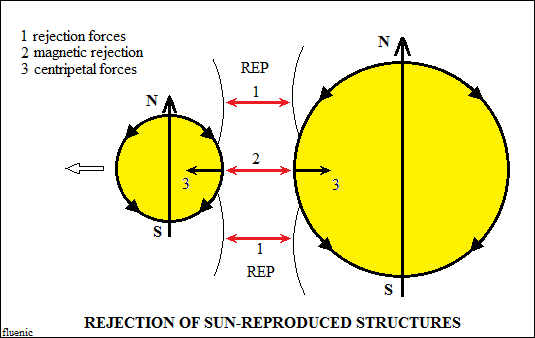Vectorial forces of
rejection.
A vortex in the solar chromosphere can become a new star, a macroscopic
vectorial structure. The reproduced structure can be decomposed by solar
centripetal forces or repelled in vectorial space, depending on the orientation
of the orthogonal circuits. For the second variant, the repulsive forces
already
exist in the structure. The new star reproduced in the chromosphere has
the
same structure as the sun: Orthogonally closed vector circuits, centripetal
forces and radial polarizations. The radial, "electrostatic"
vector polarizations
repel with those of the sun. The external (magnetic) circuits, if they
have the
same direction and sense, repel. Thus, the new structure leaves the solar
chromosphere with speed against the centripetal forces, and the repulsive
forces diminish with distance from the sun. For the new star, which will
become a planet, the repulsive forces do not constitute a propulsion system,
the star becoming weightless, part of the vector space, located in the
differential
rotation of the solar system. The solar system in turn is part of the
vector space
located in the differential rotation, with the orthogonally closed vector
circuits
of the galactic system. This article shows how the energy of vector space
reproduces macroscopic vector structures, a structural unit called
a system, with the same orthogonally closed vector circuits.
In other words, a galaxy is a super macroscopic structural unit, with
orthogonally closed vector circuits, with dimensions of thousands of light
years. The vector space density at the center of the circuits is similar
to a
star, it differs in size, and the gaseous substance being the arms of
star
systems. At the center of the telescopically visible circuits, it shows
a black
hole surrounded by dark energy, respectively the orthogonal, electric
and
magnetic circuits. I repeat, I repeat: the electrical phenomenon is energy,
that is, interactions of vector properties, of the same orthogonally
closed vector circuits, not through movements of invented "particles".

